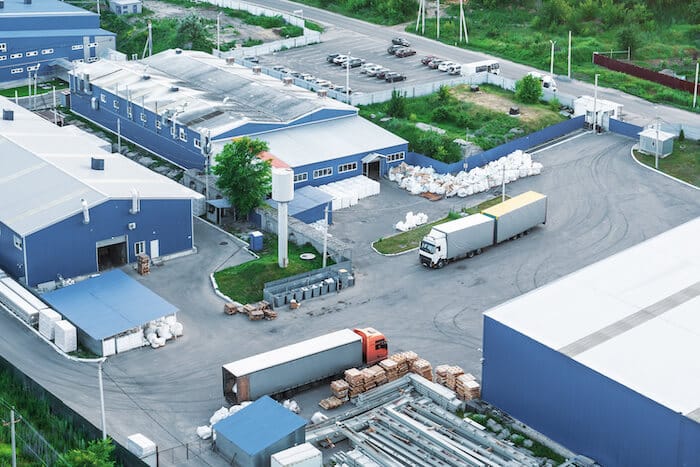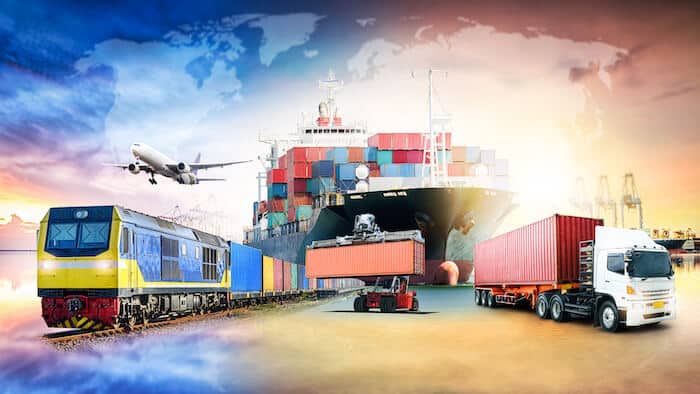If you are using nearshore or offshore manufacturing, you have to get your product from your factory to you to sell it.
This step is called international freight shipping.
The COVID-19 pandemic and subsequent supply chain disruptions taught us to take this step seriously when bringing a new product to market. Even when global logistics work well, shipping rates can eat into your profits or keep you short on inventory.
Whether you hire a third-party logistics company or have an internal supply chain team, it’s good to know your options for your international shipments.
In this article, we’ll cover everything you need to know about international freight shipping, including when to use it, how to keep costs down, and where to get started.
What Is International Freight Shipping?
International freight shipping is the process of transporting goods across international borders using various modes like ships, planes, trucks, and trains. It involves coordinating logistics, customs clearance, and regulatory compliance to ensure timely and secure delivery. This includes managing international shipping services, understanding international freight rates, and handling international shipping rates effectively.

Types of International Freight Shipping
When shipping goods internationally, choosing the right method is crucial for efficiency and cost-effectiveness. The two main types of international freight shipping are air freight and ocean freight. Each has its unique benefits and is suitable for different kinds of shipments. Here’s a closer look at both options to help you decide which one fits your needs.
Air Freight
Air freight is the fastest method for transporting goods across borders. It involves using aircraft to deliver cargo quickly and reliably. This method is particularly beneficial for businesses that need to move high-value or time-sensitive items rapidly. Air freight offers more frequent departures and a global reach, ensuring that your goods arrive at their destination in the shortest possible time.
When to use air freight shipping:
- Time-sensitive shipments needing quick delivery, such as perishable goods or urgent supplies.
- High-value items that require secure and fast transit, including electronics, jewelry, and pharmaceuticals.
- Lightweight and small volume goods to optimize costs, making it a cost-effective option for items where speed is more critical than size.
Air freight also provides a higher level of security for your cargo, reducing the risk of damage and theft. With strict regulations and advanced tracking systems, you can have peace of mind knowing your shipment is in safe hands.
Ocean Freight
Ocean freight is a more economical choice for shipping large volumes of goods. This method uses cargo ships to move products across seas, making it ideal for bulk shipments. Ocean freight is highly suitable for businesses looking to transport heavy or oversized items that are not urgent. It offers various shipping options, such as full container load (FCL) and less than container load (LCL), providing flexibility based on the shipment size and budget.
When to use ocean freight shipping:
- Heavy items or bulky items that are not time-sensitive, such as industrial machinery, vehicles, and large quantities of raw materials.
- Large volume shipments requiring cost efficiency, making it a preferred choice for businesses looking to minimize shipping costs.
- Goods that can endure longer transit times, as ocean freight typically takes several weeks, which is suitable for items with a longer shelf life.
Ocean freight is also more environmentally friendly compared to air freight, as it has a lower carbon footprint. Additionally, it provides a range of services, including door-to-door delivery, customs clearance, and cargo insurance, ensuring a smooth and hassle-free shipping experience.
How To Determine Which Type Of Shipping To Use
When determining your requirements for cost and timelines associated with international freight shipping, you need to understand how you’re going to ship, how you will pack your product in bulk, and the rules, regulations and tariffs that will be in effect for the countries your are shipping from, through, and to.
Whether by ocean, rail, or air freight, there are five common steps to the process:
1. Export Haulage
The freight service moves products from the factory to the port, rail terminal, or airport where they will leave the country of origin. This may require warehousing along the way, consolidating products, or special packaging for the mode of transport. Sometimes this is called door service.
2. Export Customs
Every country has its regulations, fees, and tariffs for exporting goods. This is a critical step to pay attention to because if you or your shipping partner doesn’t handle export customs properly, your shipment can be delayed, and you might pay unexpected or unnecessary costs. Managing customs clearance procedures and ensuring accurate customs documentation are essential to avoid these issues and ensure a smooth export process.
3. Transportation
Once past customs, your product gets loaded in whatever mode of transport you’re using and shipped via some combination of air cargo, ocean freight, and land freight services.
Ocean freight shipping services and ocean freight forwarders play a significant role in managing shipments by sea. Air freight transportation is handled by air freight carriers, ensuring timely delivery of high-value items. This stage may involve dealing with dimensional weight, hazardous materials, heavy shipments, and additional services. Efficient handling of air freight capacity and monitoring air freight costs and growth are crucial for optimizing the transportation process.
4. Import Customs
Upon arrival, your shipment must clear customs. Customs clearance is a complicated process, and it’s important that you have the right contact. This can make a big difference in how fast or even if you clear customs at all. Ensuring proper customs clearance procedures and accurate customs documentation is crucial to prevent delays and additional costs.
5. Import Haulage
Last but certainly not least is how your product travels from your warehouse or distribution center. Your logistics solution provider must find the best domestic freight shipment option to finish the journey. What each of these steps looks like is determined by your product. You must account for your shipment’s volume, size, and actual weight because they will have the biggest impact on each step.
Before we move on, it’s helpful to know some common acronyms logistics providers use to capture how large your shipment is relative to the size of a shipping container or standard truck sizes:
- LCL: Less than container load
- FCL: Full container load
- LTL: Less than truckload
- FTL: Full truckload
Additionally, consider factors such as the destination countries, business days required for transit, and any specific requirements for handling bulk cargo. Proper planning ensures efficient and cost-effective import haulage.
When Should You Use International Freight Shipping Services?
You must use international freight shipping if you’re making your product in another country. But you can pass this process on to your manufacturer or a third party. For example, if you’re using Fulfilled by Amazon (FBA), someone else will move your product from your foreign manufacturing partner to Amazon’s warehouses.
However, you’re trusting a pivotal part of getting your product to market to someone else. You’re at their mercy for schedule, cost, and breakage.
If any of the following are true, you should be directly involved in your international freight shipping:
- The shipping cost is a substantial portion of your product’s price.
- Your product has stringent transportation, import, or export regulations.
- The tariffs on your product are expensive or complicated.
- Delays or not getting your product when expected significantly impact costs or sales.
Additionally, consider if your product includes fragile items or hazardous materials that require special handling. Another thing to consider is your familiarity with the logistics of global freight. If you’re new to this, working with a logistics service may be a good place to start. They can provide instant quotes and help navigate the complexities of international shipping.

How Can You Lower Shipping Costs?
Global freight is big business, and it’s in the middle of a long-term growth trend. The global logistics market is projected to double over the 10 years from 2017 to 2027, from $7.6 trillion to $13 trillion.
As that market grows, so will the options for your company to save on their international freight costs. Below are some suggestions you can apply to understand and optimize your freight services costs.
Given the current environment with rising transportation costs, any one of these recommendations can save you money and reduce your CPG.

1. Only Pay for the Speed and Certainty You Need
How quickly you move your product is the biggest driver of cost. The cost of air freight is much higher than ocean freight. And within a given freight class, you simply pay more for your product to move faster. You also have to pay more to move to the head of the line or move product in an LTL (Less than Truckload) or LCL (Less than Container Load) situation. When you get a shipping quote, look at transit time, the cost of customs brokerage, and other shipping options to compare prices and their impact on your revenue.
The accuracy of your delivery date can drive up prices. A broader set of dates, called the delivery window, is less expensive than a hard due date. You save money as logistics companies use this flexibility to schedule cost-effectively and consolidate shipments to create a full container load (FCL).
To avoid paying for speed and certainty, consider keeping inventory of your product as a buffer. Storage cost is associated with that, but it may be less than the increased shipping costs.
- Air Freight: Ideal for urgent and high-value shipments but comes with higher costs.
- Ocean Freight: More economical for less time-sensitive and bulk shipments.
- LTL and LCL: Useful for smaller shipments but may incur higher costs due to consolidation needs.
By balancing speed and certainty with your inventory strategy, you can optimize your shipping costs effectively. Take a look at our article on supply chain strategies for more suggestions on how you can be less sensitive to schedule.
2. Optimize Volume and Weight
Shippers charge by volume and weight. You usually pay per container, truckload, or train car. Your cost per product goes down if you can fit more in a container. For example, the inside of a 40-foot shipping container is around 93 inches tall. So you should design your shipping boxes to stack close to 93 inches. If the boxes are 2 feet tall, you can stack three. But you can stack four if they’re three-quarters of an inch shorter. Ensuring your packaging maximizes space without adding unnecessary bulk is crucial, which involves managing dimensional weight efficiently.
Weight impacts the cost of every transport mode because it affects fuel consumption, and this is especially true for air freight. Minimizing your product’s weight should be a design requirement if you plan on shipping by air. Utilizing the volume of the container efficiently can reduce the number of shipments, as calculated by cubic meter.
Packaging is the biggest factor of weight once your product is designed. Remember this when deciding what materials you use to secure your product for transport. Moving from wood to plastic pallets or removing pallets can impact weight and shipping costs. Choosing lighter packaging materials that still protect your product during transit can significantly affect your bottom line.
All these considerations should be a part of planning during the design phase of product development or later if you optimize your current designs. By focusing on optimizing volume and weight, you can significantly reduce your shipping costs and improve overall efficiency.
3. Be Accurate With Paperwork
Getting stuck in customs when your products cross a border can be expensive. It costs you time and may involve fees if your paperwork is incorrect. Make sure your bill of lading and commercial invoice are clear and accurate. Incorrect or incomplete customs documentation can cause additional costs and delays. Double-check addresses, dates, and contact information to ensure everything is correct.
In addition, how you classify your product under the harmonized tariff schedule can drive your export and import tariff costs. Make sure you explore options and pick the correct classification to avoid unnecessary expenses. Ensuring your customs clearance procedures are followed meticulously is essential to prevent costly errors.
Being accurate with paperwork is not just about avoiding delays; it’s about maintaining a smooth and cost-effective shipping process. Proper documentation ensures that your shipment moves efficiently through each stage of international freight shipping.
5. Reduce Damage and Loss
Damaged or missing goods are an often-overlooked cost in international freight shipping. Having to toss out or repair products can add up quickly. Your product and its packaging need to withstand all the bumps and occasional falls that they encounter making their way to your shelves. Make sure you understand how your product moves throughout the entire journey.
It’s not uncommon for a product to ship unscathed, only to shatter when it falls off a forklift because the box is top-heavy. To prevent such issues, ensure your packaging is robust enough to handle the rigors of shipping. Investing in proper cushioning and protective materials is crucial for dealing with fragile items.
Handling hazardous materials requires even more stringent measures to avoid damage and ensure safety. Ensure you follow all necessary protocols for hazardous materials to prevent accidents and losses.
By thoroughly assessing and improving your packaging and handling processes, you can significantly reduce the chances of damage and loss during transit. This will save costs and ensure your products reach customers in perfect condition, enhancing your reputation and customer satisfaction.
6. Get Multiple, Accurate Freight Quotes
The international freight shipping world is very competitive. Some small suppliers handle just one part of the process, while giant multinational companies manage the entire logistics chain. They negotiate prices with each other and their customers based on the current state of the market. To get the best freight rates, obtain quotes from multiple logistics companies. Ask for different options on speed and delivery window to see how much you can save.
When requesting quotes, provide an accurate estimate of your volume and weight. If you’re vague, they will estimate high. Incorrect estimates can lead to overage fees, increasing your shipping costs. Using a freight rate calculator can help you provide precise details. Ensure you account for all potential charges, including customs clearance and additional services.
Here are some tips for getting accurate freight quotes:
- Provide Accurate Details: Give detailed information on your shipment’s volume and weight to avoid high estimates and overage fees.
- Use a Freight Rate Calculator: These tools can help you estimate costs based on your shipment’s specifics.
- Consider Instant Quotes: These allow for quick and easy comparison of different freight options, helping you find the most cost-effective solution.
You can optimize your shipping costs by getting multiple, accurate freight quotes and carefully comparing them.
Who Provides International Freight Shipping?
The best way to look at international freight shippers is to classify them by the services they provide. Do they manage the whole journey and physically transport your products? Do they handle customs clearance? Or are they middlemen who get quotes for every step in the process?

International Freight Forwarders
Companies that handle the entire process refer to themselves as international freight forwarders. These companies manage the logistics from start to finish, including coordinating multiple modes of transport such as ocean freight forwarders and air freight carriers. They ensure your shipment moves smoothly through each stage, from pickup to delivery.
Global Logistics Companies
If a company goes a step further and treats moving products as a system, putting processes and technology in place to manage and optimize that system, they may refer to themselves as a global logistics company. These companies offer comprehensive international freight services, including robust digital systems, multiple modes of transport, and a thorough understanding of regulations, rules, fees, and tariffs at every border your product will cross.
Freight Marketplaces
On the other end of the spectrum are marketplaces where you can bid for each portion of your product’s global shipping journey. These platforms allow you to find and compare quotes from various suppliers. However, you’re on your own here, so make sure you or someone on your team can manage the entire process. When things go wrong, they should be able to untangle the mess and get things back on track.
Choosing the right provider depends on your needs:
- International Freight Forwarders: Ideal for those seeking a comprehensive solution managed by experts.
- Global Logistics Companies: Best for businesses looking for a systematic approach with advanced technology and process optimization.
- Freight Marketplaces: Suitable for those who prefer to manage the process themselves and are looking for cost savings through competitive bidding.
Whichever company you choose should have robust digital systems, multiple modes of transport, and a good understanding of regulations, rules, fees, and tariffs at every border your product will cross.
Where to Get Started With Your International Freight Shipping
Understanding your needs is the first step in setting up your international freight shipping. Document what you’ll ship, where you’ll ship it, and when. And don’t forget to include this information in your product specifications and communicate them to your manufacturing partner.
Next, you need to decide who will manage the process. Maybe your company has an internal supply chain team that will contract out or handle each step themselves. Or perhaps you will outsource the entire operation to a third-party logistics company. Finally, you may choose to hire an international freight forwarder and build a relationship with them.
Regardless of your path, Gembah has the expertise and the contacts to optimize getting your products from factory to shelf.
Our product development process includes logistics and compliance. Or, you can take advantage of our logistics services, which include obtaining quotes for drayage, oversight of cargo transportation and loading, and assisting with customs.
Make sure that this critical step in bringing your product to market positively impacts your bottom line — contact us today.



